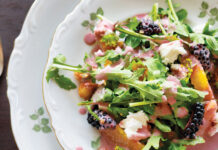Story by Sky Barnhart | Photography by Jason Moore
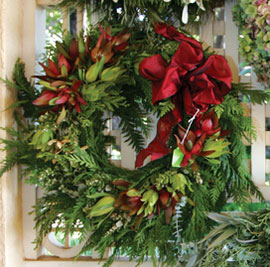 I am riding in the back of a pickup truck, bumping down a rutted grassy road between stands of pine and cedar and eucalyptus. Above the trees, the sky is eggshell blue, and the sun filters through the branches to ease the chill of the Upcountry morning.
I am riding in the back of a pickup truck, bumping down a rutted grassy road between stands of pine and cedar and eucalyptus. Above the trees, the sky is eggshell blue, and the sun filters through the branches to ease the chill of the Upcountry morning.
The truck stops, and we scramble out onto the leaf-rustling forest floor. Behind us, other trucks in our caravan unload their cargo of women—women wearing jeans, flannel shirts, gloves, and sturdy boots—all armed with clippers. They fan out among the trees, moving assuredly, relaxed but purposeful. They’ve been doing this for a long time.
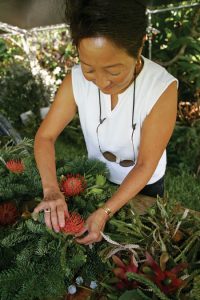 Since this is my first time “collecting,” I stick close to Judy Bisgard, venerated leader of the group. In army-green pants, with her hair tucked under a visor, she looks ready for anything: rain, getting lost, trucks mired in the mud. It’s all happened during the 10 years she’s been guiding her dedicated group of volunteers to gather the trappings of Christmas.
Since this is my first time “collecting,” I stick close to Judy Bisgard, venerated leader of the group. In army-green pants, with her hair tucked under a visor, she looks ready for anything: rain, getting lost, trucks mired in the mud. It’s all happened during the 10 years she’s been guiding her dedicated group of volunteers to gather the trappings of Christmas.
“Today, we’re going mainly for cedar and pine, maybe a few natives,” she says.
She walks up to a stately cedar and pulls down a bough. Clip; her well-worn clippers cut through the papery red branch and it swishes to the ground. Clip, clip; another two boughs fall. She picks them up and moves to the next tree.
I walk behind her; clip, clip. It feels wonderfully illegal, as if at any moment, a khaki-uniformed ranger will leap out and confiscate our clippers. But we have a permit to be doing what we’re doing, and it’s all for a good cause: the perpetuation of one of Maui’s oldest nonprofit foundations for the arts.
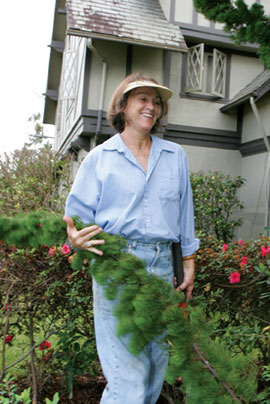
Volunteers for Hui No‘eau Visual Arts Center, these women move through the woods, clipping as they go. Fragrant branches of cedar, heavy boughs of pine, tiny pinecones, sprays of fern, delicate dry twigs—all will become the gorgeous wreaths that adorn the walls and walkways of Kaluanui, home of Hui Noe‘au, at Christmastime.
During the month of December, the gracious mansion, built in 1917 by C.W. Dickey for Harry and Ethel Baldwin, is transformed into an old-fashioned postcard of holiday elegance and charm, missing only the snow. Every year, many Mauians make the trip to Kaluanui to buy fresh, pine-scented wreaths. Not only are the wreaths beautiful and made with local, natural materials, but they’re also priced affordably ($35 and up), and most importantly, all proceeds go to support the Hui’s art programs.
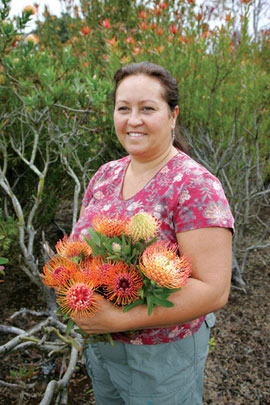
In the past, the wreaths were available during the Hui’s annual display of artists’ work known as “Christmas House.” This year, the event has shifted into a more localized affair called “Hui Holidays at Kaluanui.”
“We wanted to create more of a focus on our own art studios and the art created here, rather than bringing in outside crafters and vendors,” says Kathy McBride, Hui Noe‘au events coordinator. “We’ll still have all the wonderful decorations and unique gifts for sale.”
Hui Holidays at Kaluanui will take place on Saturday, December 2, from 10 a.m. to 4 p.m., featuring a woodworking exhibit by Maui Woodworkers Guild, studio tours, gifts, and of course, the wreaths.
For some longtime Hui members, it just wouldn’t be Christmas without the wreathmaking. Sandra Florence, who heads the Hui’s Art Affair fundraiser, has been coming on the collecting trip for many years. “It’s really an excuse to spend a day in the mountains, breathing the fresh air,” Florence says. “It’s when I know the holidays are here.” And, of course, “it’s also about getting to put our trucks into four-wheel drive!
Most of the collecting takes place on private land and estates through age-old agreements between the Hui and Maui landowners. The women take extreme care to ensure that the work is conducted carefully, unobtrusively, and with respect to the native environment. Rather than depleting the trees, selective cutting rejuvenates them, like trimming back a hedge for fuller growth, according to Bisgard. Cutting down pine and eucalyptus does the forest a favor, as the species are invasive to Maui.
The collecting is both social and reflective. We fall into an easy rhythm: clip and walk, carry our armloads to the truck, fling them on the springy pile in back, clip and walk. The only sounds are the too-wheeet of birds, wind rustling the treetops, and the women’s soft laughter as they catch up on each other’s work, children, homes, and lives.
“Judy, is this a no-no tree?” someone asks.
“No, that one’s okay,” Bisgard replies.
For the most part, native trees and plants are off-limits for collecting. Koa’s glossy leaves and sandalwood’s tiny red flowers would look wonderful in a wreath, but Bisgard is judicious about using the natives only for select purposes.
“The hard part is knowing where and how to pick, and knowing what’s good to get,” Bisgard says. “Different textures are what we’re looking for—feathery, thick, lacy, poky—interesting leaf shapes that will last and dry well.
“Be conscious of what wilts. Something that seems so perfect and pretty today may be droopy by tomorrow.”
Collector Sally Baldwin (great-granddaughter of Ethel) praises Bisgard’s resourcefulness. “Once, we were hiking with Judy out towards Hana, and she was picking ferns. By the time we were done with the hike, she’d woven a haku lei.”
Bisgard grew up on Maui, riding horses with her father up the slopes of Haleakala and learning the native plants and flowers. She went to school on the Mainland to earn her degree in history with a minor in art. After returning to Maui with her husband, Bill, an engineer for HC&S, she served on the State Foundation on Culture and the Arts, among other activities. She’s taught classes at the Hui in haku lei-making, basketweaving and, of course, wreathmaking.
Once the collecting is completed, the women heap the boughs under white tents on Kaluanui’s lawn. They stand at long wooden tables to craft their wreaths. Most of the wreaths follow a popular theme: pine-and-cedar-trimmed with bright pincushion proteas or soft kangaroo paws, tied with red ribbons. But there are many exceptions.
Bisgard’s wreaths rank almost as art: giant branches of magnolia, wired together; silvertree leaves layered in silvery splendor; dry twigs and moss woven into a “natural” wreath.
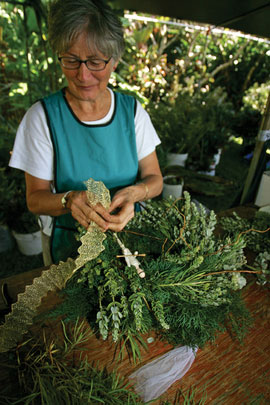
When it comes to design, there are no rules, except: “Always put your wire on first—otherwise you’ll wonder, ‘where do I hang the thing?’” cautions Sally Longhi (of Longhi’s restaurants). She deftly wraps a thin green wire with a white ribbon around an unadorned wreath—“it saves untold trouble.” A talented floral designer, Longhi does the flowers for her daughter’s business, Blue Sky Weddings.
At Kaluanui, the women work for many days, making more than 100 wreaths. Each wreath takes from one to three hours. As they finish each one, the women hold them up for critique. “Ooh, that one needs a little red there . . . maybe another sprig there . . . why don’t you try a different ribbon?”
My creation—a small, eucalyptus-encrusted attempt—is admired, but sent back for “more red.” Three tiny apples and a giant crimson bow later, it is much improved and given a $45 price tag. I’m proud to carry the wreath inside Kaluanui and hang it in the stairwell with the others.
After two weeks of collecting, a week of wreathmaking, two weeks of selling and fundraising, and then the holidays, Bisgard and her crew of fellow volunteers are exhausted. But at the wrap-up meeting in January, results show that 2005 wreath sales were the most successful ever, with a net profit of $7,691—all going to programs at the Hui.
This year, Bisgard hopes to encourage newcomers to try their hand at wreathmaking. “We’re trying to get some younger people involved, some people who have never done it. We can produce a lot more wreaths; we just need the time, the energy, and the manpower.”
Or, in this case, shall we say—the womanpower.





